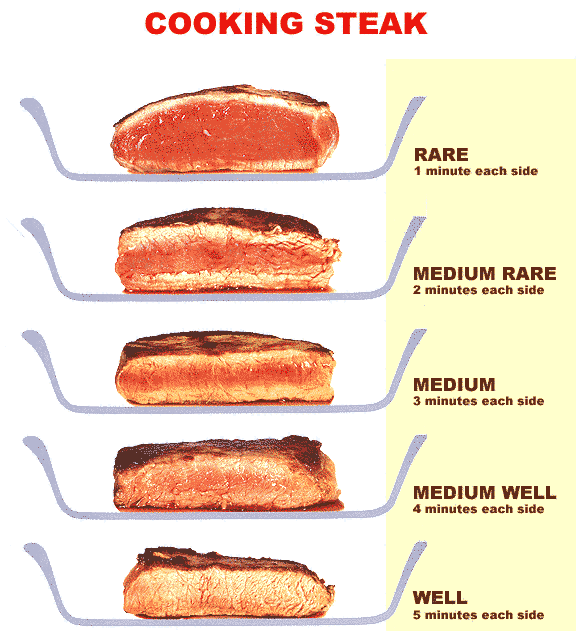When it comes to nutrients there?s actually no difference between a steak that?s cooked rare or well done ? the contrast is in the flavour and juiciness. For steaks, common graduations of doneness are based on the colour, juiciness and internal temperature. So, what?s the difference between rare, medium, and well-done steak? Find out more here?

Rare
This refers to a steak that?s been cooked for a very short period of time ? leaving the centre cool and red in colour. It?s just a stage up from raw meat ? but cooked on the outside. Steak doesn?t contain parasites that chicken and pork do ? eating it rare doesn?t pose any health risks.
Medium Rare
Medium rare steaks are warm with a pink to red centre ? soft and juicy on the inside and firm on the outside.
MediumMore grey-brown than pink in the centre this steak has a more pronounced band of pink in the middle.
Medium Well
Just a hint of pale pink inside this steak will be mostly grey-brown throughout ? ideal if you want a slightly juicy steak without any blood.
Well-Done
Well-done steaks are normally charred on the outside with and are greyish-brown all through with no sign of pink ? they?re cooked on a slow heat to keep from toughening.
Types of SteakNow you know just how steak can be cooked to get the best flavour here?s an insight into the types of steak you can try:Sirloin ? this lean cut of meat can become tough if it?s cooked for too long ? for a tender juicy steak its best served rare.Rib Eye ? about 6?8 minutes is all you need to cook an inch thick steak to produce a super flavour and juicy cut of prime rib.T-Bone ? this steak is cut from the loin and tenderloin and can be cooked for a while longer if you prefer.Filet Mignon ? also known as a fork-tender cut of beef cut from the heart of the tenderloin ? this steak should be rare to be fully enjoyed.New York Strip Steak ? flavoursome strips of steak from the heart of the beef loin take about 6?8 minutes to cook on average.
Healthy Cooking AdviceIt?s been proven that meat cooked until its well-done contains more potential carcinogens than meat cooked for a shorter time ? laboratory tests have shown that this increase in heterocyclic amines can cause a higher risk of colon tumours and colon polyps. High intakes of well-done meat have also been linked to a greater risk of certain cancers.
Research also suggests that heavy red meat eaters have an increased risk of developing type II diabetes, coronary heart disease, and colorectal cancer ? so less than 18 ounces a week is recommended. It?s important to choose steaks that are lower in fat ? such as sirloin or beef tenderloin ? and cook your steak to minimise the formation of heterocyclic acids.
Keeping portions of steak small will cut down on cooking time ? and pre-cooking in the microwave for just two minutes will significantly reduce the acids when cooking. Marinating steaks before cooking with citrus juices, spices, and vinegar may prevent carcinogen formation ?and cooking at a lower temperature will also help.
For an inch thick steak try this cooking option: season well with salt and pepper and sear in a hot cast iron pan. Put in the oven pre-heated to 160*C testing with a thermometer until centre of steak reaches 140*C. Take out of the oven and wrap in foil ? let it rest at room temperature for at least five minutes. This way the steak will lose only 5% of its moisture and be juicy and pink all the way through.
Samson?s PaddockVisit this restaurant in Mosman Park and get a steak tasting board that?s second to none ? only the highest quality beef in Australia from the best single paddock producers will be cooked for you.
There?s a choice of steak from grass fed and grain fed cows ? providing healthy and nutritious cuts of meat that?ll be cooked to perfection. Your chef is passionate about local produce and will provide you with exciting steak dishes paired with a choice of over 20 whiskeys so that you can learn about and taste the best beef in Australia alongside the most sought-after whiskey from around the world.